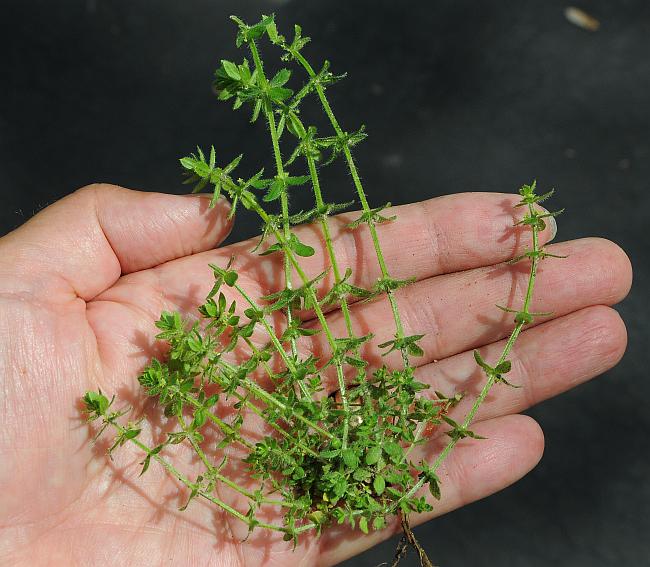Galium pedemontanum (Bellardi) All.
Bedstraw

Introduced
CC = *
CW = 5
MOC = 50
© SRTurner
Galium pedemontanum (Bellardi) All.Bedstraw | |
 |
Introduced CC = * CW = 5 MOC = 50 |
© SRTurner |
|
Family - Rubiaceae Habit - Annual forb. Stems - Weakly ascending to erect, to 40 cm, often multiple from base, evenly and sparsely to densely pubescent with relatively long, straight, spreading, slender hairs, usually also roughened with minute, prickly, downward-curved hairs on the angles.
Leaves - Appearing whorled with 4 per node, usually spreading in orientation. Leaf blades 3-10 mm long, 1.5-5.0 mm wide, narrowly elliptic to elliptic or lanceolate, the smaller ones occasionally ovate, rounded or angled to a bluntly or sharply pointed tip, the midvein not extended into a point, rounded or angled at the base, not glandular, hairy along the midvein on the undersurface, with only the midvein visible, the margins with relatively long, spreading to ascending, slender hairs, flat or only slightly curled under.
Inflorescence - Axillary from all but the lowermost leaves, consisting of solitary flowers or more commonly small clusters or fascicles.
Flowers - Flowers (1)2 or 3, the stalks 1-2 mm long. Calyces minute or absent. Corollas 0.4-0.6 mm long, 4-lobed, yellowish green to pale yellow. Stamens 4, the anthers exserted. Style 2-lobed, the stigmas 2, capitate. Ovary inferior, 2-locular, with 1 ovule per locule, glabrous.
Fruits - Schizocarps 1.0-1.5 mm long, 1-2 mm wide, the surface glabrous, smooth to granular. Flowering - April - July. Habitat - Lawns, pastures, fields, open disturbed areas. Origin - Native to Eurasia. Lookalikes - Galium virgatum. Other info. - This small introduced weed was unknown in Missouri at the time of Steyermark's 1963 publication. It was first reported in the state in the mid 1970s, and since that time has spread rampantly. As of early 2020, it has been reported from 50 (43%) of Missouri counties, mostly in the southern half of the state. Currently the main distribution in the continental U.S. is centered on Missouri and Arkansas, though it occurs more sporadically into Pennsylvania and New York, and also in the Northwest. The plant is easy to recognize by its 4-parted leaf whorls and minute yellow flowers which mostly have four lobes. The fruits lack the hooked hairs found on those of some other species of Galium, but evidently have no trouble distributing themselves far and wide. The plant can form dense colonies in lawns and fields. Photographs taken near Labadie, Franklin County, MO, 4-21-2012, 4-24-2012, 5-1-2019, and 4-7-2021 (SRTurner). |